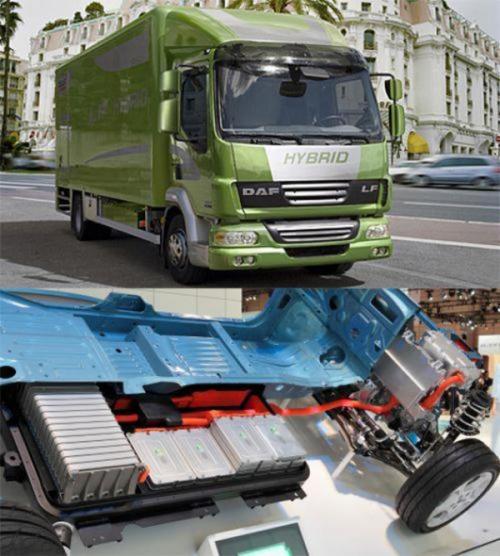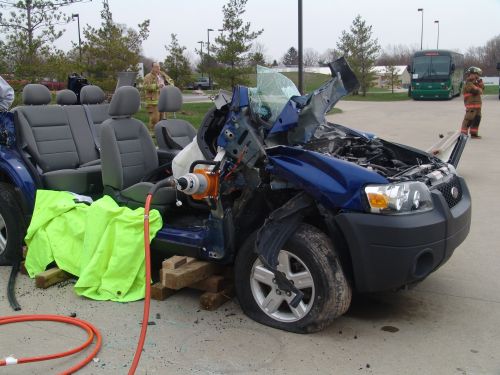Electric & Hybrid Vehicles - Part 2
Other Considerations
Due to the location of battery cells (mostly in EV’s) we should not stabilise or lift underneath the central part of the floor of the vehicle. This should not impact on our current methods of stabilising or lifting as we normally use the vehicles existing jacking points, a proven area of strength.
Some of the vehicles provide addition power by use of solar panels. These are used for cooling/heating systems or for trickle charging of auxiliary batteries. An example of such a system is the Toyota Prius which generates a maximum output of 27 volts with a maximum current of 3-4 amps. This system is not connected to the HV or 12v system and cannot feedback power. Cutting of these solar panels will not be hazardous, with the exception of the fragments that may result.
Of course it is not just cars. This technology is now available on commercial vehicles such as the Renault Kangoo EV and the DAF LF Hybrid.

Cross section of a Nissan Leaf showing HV battery construction and location.
Batteries
Both lithium-ion and nickel metal hydride batteries contain an electrolyte solution. If the battery cell is breached then leakage of this solution may be possible. Due to the fact that the lithium-ion battery is made of many small sealed battery modules, leakage should not occur in large quantities. Electrolyte has the following characteristics:
- Clear in colour
- Sweet odour
- Similar viscosity to water
- Skin and eye irritant
- Highly flammable
- Contact with water vapours in the air creates an oxidised substance which will also irritate skin and eyes.
Construction
Once the steps above have been taken, we are, effectively, extricating from a conventional vehicle. This means that we have the issues of new car technology to deal with during the rescue process.
The majority of hybrid vehicle batteries are located under or behind the rear seats and the batteries used in EV’s are generally located in the floor pan. In both instances they are very well protected by the construction of the vehicle. Indeed hybrid and EV’s are subjected to exactly the same crash test as ICE vehicles and are scoring just as well in most cases. The location of these batteries should not affect our rescue processes, but an appreciation of their location is vital, especially when creating internal space by use of cross ramming (either vertically or horizontally)
Tools
Theoretically, the presence of hybrids/EV’s on scene means we have a little more to consider and a few more steps to take to ensure safety of crews. In order to recoup this time, we need to have the smartest tools that have been developed with new car technology and construction in mind. This ability to overcome the latest strength with wider blade opening capacity means that the number of cuts on scene is reduced, making extrication quicker.
Cutters and spreaders that are light and ergonomic lighten the physical burden on rescuers. These smaller, lightweight tools are easier to control, of course improving the safety of the handler.
Rams which manually extend before they use hydraulic force mean that physical entrapment can be removed far quicker.
Manufacturers are committed to reducing time on scene, which is why we now have single hoses and couplings that can be changed under flow with one hand in the standing position, again reducing the impact on rescuers. These single hose systems are quicker to deploy, easier to manage on scene.
Hydraulic pump advances now see 3 stage units delivering more oil at critical pressures, allowing more tool speed. They are also casualty friendly due to very low noise output; this allows casualty assessment to go on, uninterrupted throughout the space creation phase of the rescue.
Conclusion
Awareness of the hazards and potential risks from hybrid and EV’s is crucial. However awareness alone can lead to a wholly defensive approach to this type of extrication. We must introduce context. In many countries this type of vehicle makes up less than 1% of all registered vehicles. Couple this statistic with the number of extrications taking place daily (no one knows this figure, but it must be thousands) and yet we do not hear of rescuers being seriously injured, or worse, by this technology.
Dash lift performed on Ford SUV Hybrid. By following safety guidelines extrication rescue can be safely performed on hybrids.
It’s my view that an understanding of the hazards and the steps that need to be taken when extricating victims from hybrid vehicles will ensure the safety of crews on scene. This coupled with the right choice of tools, specifically designed for new car construction, ill allow us to extricate in a safe and timely manner.
As ever I welcome your thoughts!
Ian Dunbar
